关于it作人称代词的用法
it的用法
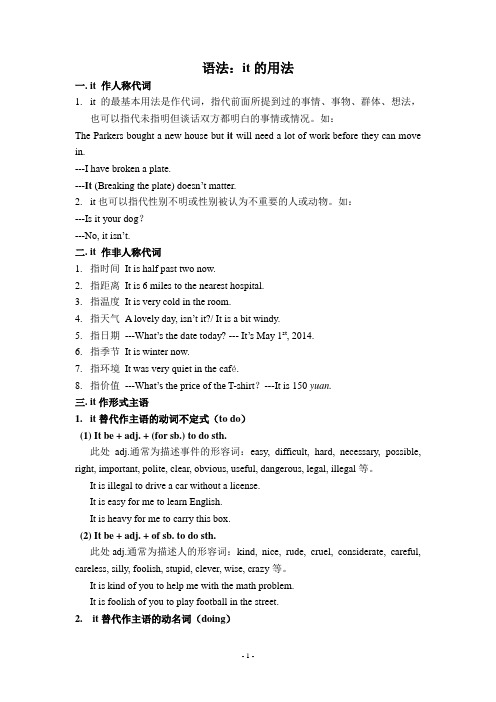
语法:it的用法一.it 作人称代词1.it的最基本用法是作代词,指代前面所提到过的事情、事物、群体、想法,也可以指代未指明但谈话双方都明白的事情或情况。
如:The Parkers bought a new house but it will need a lot of work before they can move in.---I have broken a plate.---It (Breaking the plate) doesn’t matter.2.it也可以指代性别不明或性别被认为不重要的人或动物。
如:---Is it your dog?---No, it isn’t.二.it 作非人称代词1.指时间It is half past two now.2.指距离It is 6 miles to the nearest hospital.3.指温度It is very cold in the room.4.指天气A lovely day, isn’t it?/ It is a bit windy.5.指日期---What’s the date today? --- It’s May 1st, 2014.6.指季节It is winter now.7.指环境It was very quiet in the café.8.指价值---What’s the price of the T-shirt?---It is 150 yuan.三.it作形式主语1.it替代作主语的动词不定式(to do)(1) It be + adj. + (for sb.) to do sth.此处adj.通常为描述事件的形容词:easy, difficult, hard, necessary, possible, right, important, polite, clear, obvious, useful, dangerous, legal, illegal等。
it的用法
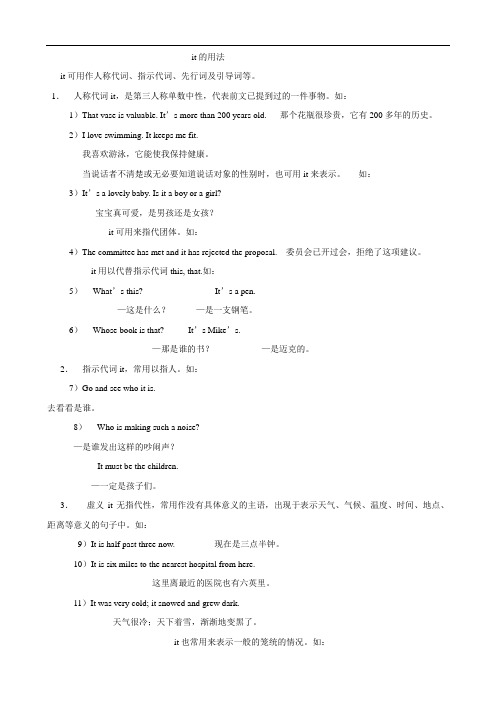
it的用法it可用作人称代词、指示代词、先行词及引导词等。
1.人称代词it,是第三人称单数中性,代表前文已提到过的一件事物。
如:1)That vase is valuable. It’s more than 200 years old. 那个花瓶很珍贵,它有200多年的历史。
2)I love swimming. It keeps me fit.我喜欢游泳,它能使我保持健康。
当说话者不清楚或无必要知道说话对象的性别时,也可用it来表示。
如:3)It’s a lovely baby. Is it a boy or a girl?宝宝真可爱,是男孩还是女孩?it可用来指代团体。
如:4)The committee has met and it has rejected the proposal. 委员会已开过会,拒绝了这项建议。
it用以代替指示代词this, that.如:5)--- What’s this? --- It’s a pen.—这是什么?—是一支钢笔。
6)--- Whose book is that? --- It’s Mike’s.—那是谁的书?—是迈克的。
2.指示代词it,常用以指人。
如:7)Go and see who it is.去看看是谁。
8)--- Who is making such a noise?—是谁发出这样的吵闹声?--- It must be the children.—一定是孩子们。
3.虚义it无指代性,常用作没有具体意义的主语,出现于表示天气、气候、温度、时间、地点、距离等意义的句子中。
如:9)It is half past three now. 现在是三点半钟。
10)It is six miles to the nearest hospital from here.这里离最近的医院也有六英里。
11)It was very cold; it snowed and grew dark.天气很冷;天下着雪,渐渐地变黑了。
人称代词it的用法总结
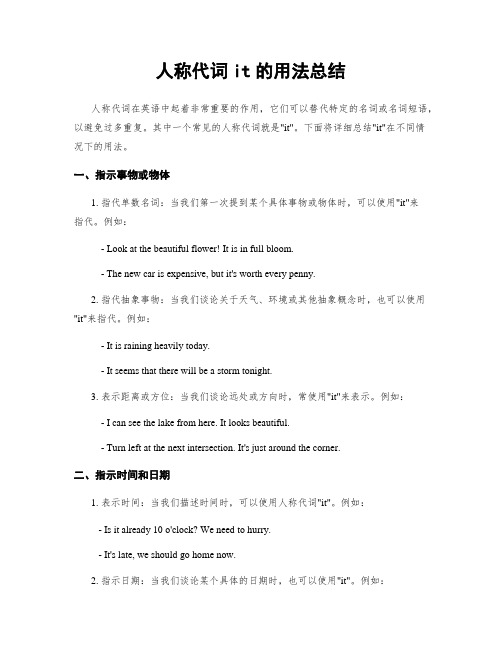
人称代词it的用法总结人称代词在英语中起着非常重要的作用,它们可以替代特定的名词或名词短语,以避免过多重复。
其中一个常见的人称代词就是"it"。
下面将详细总结"it"在不同情况下的用法。
一、指示事物或物体1. 指代单数名词:当我们第一次提到某个具体事物或物体时,可以使用"it"来指代。
例如:- Look at the beautiful flower! It is in full bloom.- The new car is expensive, but it's worth every penny.2. 指代抽象事物:当我们谈论关于天气、环境或其他抽象概念时,也可以使用"it"来指代。
例如:- It is raining heavily today.- It seems that there will be a storm tonight.3. 表示距离或方位:当我们谈论远处或方向时,常使用"it"来表示。
例如:- I can see the lake from here. It looks beautiful.- Turn left at the next intersection. It's just around the corner.二、指示时间和日期1. 表示时间:当我们描述时间时,可以使用人称代词"it"。
例如:- Is it already 10 o'clock? We need to hurry.- It's late, we should go home now.2. 指示日期:当我们谈论某个具体的日期时,也可以使用"it"。
例如:- I have an important meeting on Friday. It's going to be a long day.- The party is on Saturday night. It starts at 8 o'clock, so don't be late.三、指代动物和婴儿1. 指代动物:当我们不知道或不关心动物的性别时,可以使用"it"来指代动物。
it作为代词的用法总结
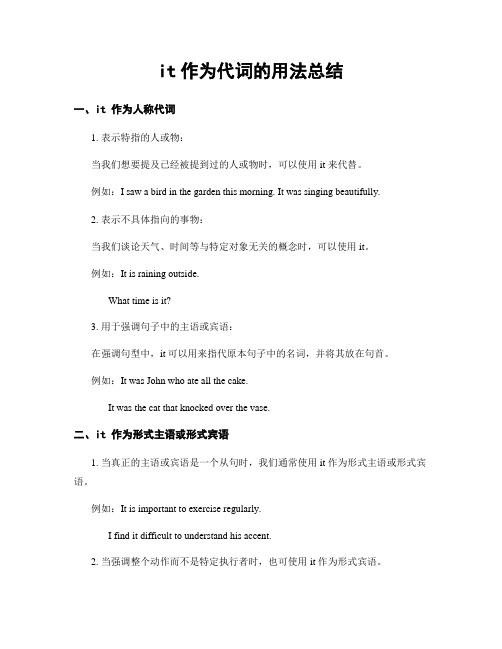
it作为代词的用法总结一、it 作为人称代词1. 表示特指的人或物:当我们想要提及已经被提到过的人或物时,可以使用 it 来代替。
例如:I saw a bird in the garden this morning. It was singing beautifully.2. 表示不具体指向的事物:当我们谈论天气、时间等与特定对象无关的概念时,可以使用 it。
例如:It is raining outside.What time is it?3. 用于强调句子中的主语或宾语:在强调句型中,it 可以用来指代原本句子中的名词,并将其放在句首。
例如:It was John who ate all the cake.It was the cat that knocked over the vase.二、it 作为形式主语或形式宾语1. 当真正的主语或宾语是一个从句时,我们通常使用 it 作为形式主语或形式宾语。
例如:It is important to exercise regularly.I find it difficult to understand his accent.2. 当强调整个动作而不是特定执行者时,也可使用 it 作为形式宾语。
例如:I find it interesting to learn new languages.She found it hard to say goodbye.三、it 作为虚主语1. 在一些较长的句子中,如果没有一个具体的主语和动词,我们可以使用 it 占据主语的位置,以保持句子的语法结构平衡。
例如:It is important to study before the exam.It seems that nobody is home.2. 在许多固定短语中,it 作为一个虚拟主语引入一个句子。
例如:It is said that he will be promoted soon.It doesn't matter if we arrive late.四、it 作为指代前文提到的内容1. 当我们在上下文中已经谈论过某个事物,并且想要通过代词回指时,可以使用 it。
人称代词it的用法和例句

人称代词it的用法和例句一、人称代词it的基本用法和形式人称代词是英语中常用的代词形式,用来表示特定人或物,其中包括第一人称(I)、第二人称(you)和第三人称(he/she/it)。
本文将重点探讨其中的第三人称代词之一——it的用法和例句。
1.基本用法作为一个第三人称单数主格代词,"it" 在句子中常被用来指代非生物事物、动物或无性别的实体。
它的主要作用是引起注意、衔接上下文以及强调某个事物。
2.主要形式在成为语句主语时,"it" 作为第三人称单数主格代词只有一个形式,并不随性别或数量而改变。
在其他情况下,例如宾格、属格等时也不变化。
二、it 作为主语时的具体使用方式1. 指示特定事物当我们需要在一个句子中引入一个特定的事物并且不涉及其性别时,可以使用"it" 作为主语。
例句:- It is raining heavily today.今天雨下得很大。
- I found a book on the table. It seems interesting.我在桌子上发现了一本书。
它看起来很有意思。
2. 表示天气状况、季节等抽象概念"it" 经常用来表示天气状况和季节,尤其是在句子中没有具体的人或物可用作主语时。
例句:- It is hot in summer.夏天很热。
- It's early spring now, and the flowers are starting to bloom.现在是初春,花儿开始绽放。
3. 引出下文或特定情境当我们需要引入一个新的话题或者指代刚刚提到过的事物时,可以使用"it" 作为主语。
例句:- I have something to tell you. It is about your sister.我有件事要告诉你。
关于你姐姐的事。
三、it 的其他用法及实例分析1. 表示动物当我们讨论动物时,特别是非人类动物时,一般会使用“it” 来指代。
it的用法及例句
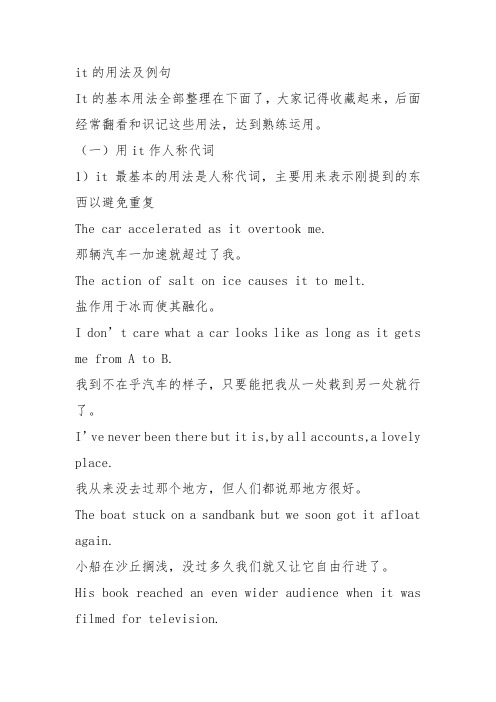
it的用法及例句It的基本用法全部整理在下面了,大家记得收藏起来,后面经常翻看和识记这些用法,达到熟练运用。
(一)用it作人称代词1)it最基本的用法是人称代词,主要用来表示刚提到的东西以避免重复The car accelerated as it overtook me.那辆汽车一加速就超过了我。
The action of salt on ice causes it to melt.盐作用于冰而使其融化。
I don’t care what a car looks like as long as it gets me from A to B.我到不在乎汽车的样子,只要能把我从一处载到另一处就行了。
I’ve never been there but it is,by all accounts,a lovely place.我从来没去过那个地方,但人们都说那地方很好。
The boat stuck on a sandbank but we soon got it afloat again.小船在沙丘搁浅,没过多久我们就又让它自由行进了。
His book reached an even wider audience when it was filmed for television.他的书拍成电视以后,受众范围更广了。
2)也可代表抽象的事物It was acclaimed as a great discovery.它被誉为一次伟大的发现。
Will you pay cash or should I charge it to your account ? 您愿意付现金还是计入您的账?Communication technologies are far from equal when it comes to conveying the truth.交流的技术在传递事实时差别是很大的。
3)也可指动物或未知性别的婴儿- Is this your dog ?- No,it isn’t.Her baby is due next month,she hopes it will be a boy. 她怀的孩子应该下月出生,她希望是个男孩儿。
It的用法
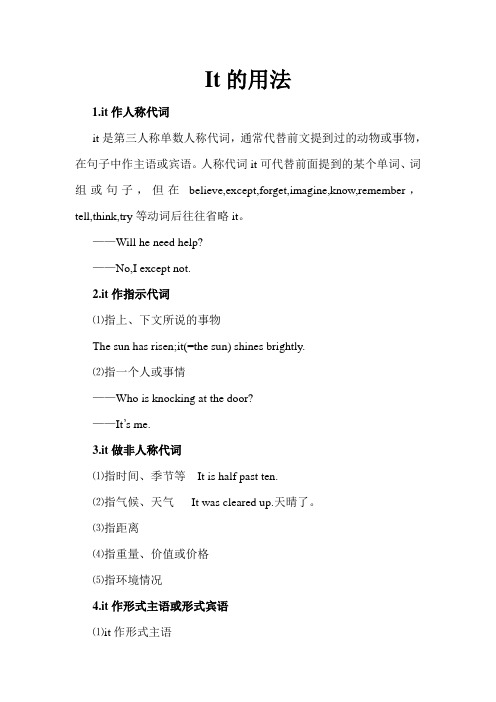
It的用法1.it作人称代词it是第三人称单数人称代词,通常代替前文提到过的动物或事物,在句子中作主语或宾语。
人称代词it可代替前面提到的某个单词、词组或句子,但在believe,except,forget,imagine,know,remember,tell,think,try等动词后往往省略it。
——Will he need help?——No,I except not.2.it作指示代词⑴指上、下文所说的事物The sun has risen;it(=the sun) shines brightly.⑵指一个人或事情——Who is knocking at the door?——It’s me.3.it做非人称代词⑴指时间、季节等It is half past ten.⑵指气候、天气It was cleared up.天晴了。
⑶指距离⑷指重量、价值或价格⑸指环境情况4.it作形式主语或形式宾语⑴it作形式主语①代替不定式It took us only an hour to go to Hangzhou by plane.②代替动名词It is dangerous playing with fire.③代替从句It’s obvious that we need more time(that we need more time是真正的主语)⑵it作形式宾语①代替不定式They find it difficult to get up so early.(to get up early是真正的主语)②代替动名词You’ll find it pleasant working here.(working here为真正的主语)③代替从句Do you think it necessary that this experiment should be repeated5.it在惯用法中的应用So it seems. 好像是如此It can’t be helped. 没有办法了Whose turn is it next?That’s the best/worse of it. 那最好/糟了Keep at it!You’ve got what it takes. 你有办法应付此情况。
it的用法

earth .
A.It B.which C.As D.That ③_A_is difficult to persuade her to stay. ④_B_is difficult is to persuade her to stay.
②It(so)happened that I had no money with me.
⑵当系表结构接有或引出的状语从句时,通常在系表结构前 使用形式主语表示说话人对某情况的看法:
①It was a good surprise to me when he said that . ②It would be a tragedy if anything went wrong. ⑶用于其他固定句型,如if it were not for…,it’s time that… 3误用形式主语的几种情况: ⑴在该用it作形式主语的地方而误用其他词
A. that B. it
C. this D. which
8. Dear me !Just look at the time !I had no idea _A_was so late.
A. it B. as
C. that
D.what
9._D_ is hard is to do good all one’s life and never do anything bad.
请看一高考题:
I hate___A__when people talk with their mouths full. A. it B. that C .these D. them
高考英语二轮复习之必备语法it的用法、常用句型(共28张PPT)

【说明】能用于此结构的动词不多,常见的 有 have, take, put, like 等
(2) 动词 + it + when (if)-从句。如: I dislike it when you whistle. 我不爱听你吹口哨。 We really appreciate it when she offered to help. 她 来帮忙了,我们十分感激。
四、it用在一些固定表达中 As someone puts it, ... 像某人所说的那样 Please see to it that ... 请务必…… When it comes to ... 当提到……时 It looks / seems as if ... 看起来好像…… It’s time for sth. 该做某事了 It’s time (for sb.) to do sth. (某人)该干某事了 It is (high) time that ... (早就)该……
Mary. I haven’t a dictionary; can you lend me one?
1. how would you like ___D__ if you were watching your favorite tv program and someone came into the room and just shut it off without as you? a. them b. one c. those d. it
五、it与one的区别 两者均可代替前面提到的事物,区别是: it指的是与前面已提到的事物为同一物,此 时的it等于“the +名词”;而one 指的是与 前面已提到的事物为同一类物,此时的one 等于“a +名词”。 e.g. I have a dictionary but I’ve lent it to
It 的用法
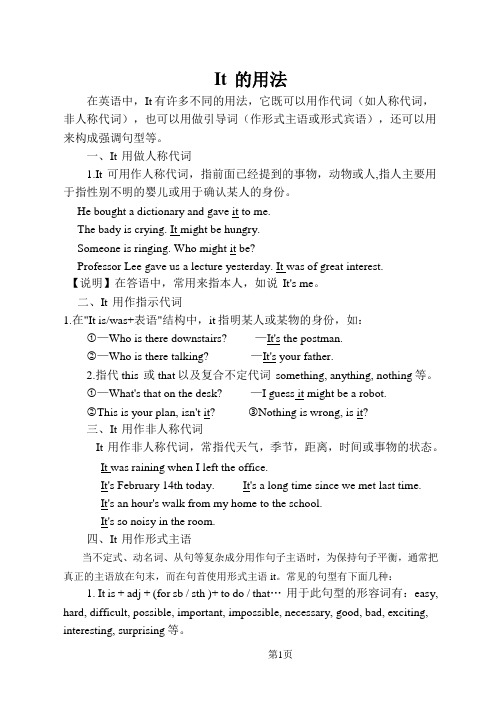
It 的用法在英语中,It有许多不同的用法,它既可以用作代词(如人称代词,非人称代词),也可以用做引导词(作形式主语或形式宾语),还可以用来构成强调句型等。
一、It 用做人称代词1.It 可用作人称代词,指前面已经提到的事物,动物或人,指人主要用于指性别不明的婴儿或用于确认某人的身份。
He bought a dictionary and gave it to me.The bady is crying. It might be hungry.Someone is ringing. Who might it be?Professor Lee gave us a lecture yesterday. It was of great interest.【说明】在答语中,常用来指本人,如说It's me。
二、It 用作指示代词1.在"It is/was+表语"结构中,it指明某人或某物的身份,如:①—Who is there downstairs? —It's the postman.②—Who is there talking? —It's your father.2.指代this 或that以及复合不定代词something, anything, nothing等。
①—What's that on the desk? —I guess it might be a robot.②This is your plan, isn't it? ③Nothing is wrong, is it?三、It 用作非人称代词It 用作非人称代词,常指代天气,季节,距离,时间或事物的状态。
It was raining when I left the office.It's February 14th today. It's a long time since we met last time.It's an hour's walk from my home to the school.It's so noisy in the room.四、It 用作形式主语当不定式、动名词、从句等复杂成分用作句子主语时,为保持句子平衡,通常把真正的主语放在句末,而在句首使用形式主语it。
英语中it用法全解析

英语中it用法全解析摘要本文主要介绍了英语中it的用法,包括以下几个方面:it作为人称代词,指代前文提到的或语境中明确的人或物。
it作为非人称代词,表示天气、时间、温度、距离等抽象概念。
it作为形式主语或形式宾语,代替不定式、动名词或从句等真正的主语或宾语。
it用于强调句型,突出句子中的某一成分。
it用于其他常见的句式和短语,表达不同的意思和功能。
1. it作为人称代词it作为人称代词,通常指代前文提到的或语境中明确的人或物。
它在句中可以作主语、宾语、定语或表语等。
例如:句子说明He took a quick look at the house and noticed it was veryold.it指代前文提到的house,作主语。
John hates children, and it is difficult to say why.it指代前面提到的事情,作主语。
She made it clear (that) we were not welcome.it作形式宾语,真正的宾语是that引导的从句。
It's me.it作形式主语,真正的主语是me。
2. it作为非人称代词it作为非人称代词,表示天气、时间、温度、距离等抽象概念。
它在句中通常作主语或宾语。
例如:句子说明It is raining.it表示天气,作主语。
It is an hour's walk from my home to the school.it表示距离,作主语。
It is a pity that I didn't think of it earlier.it表示一般情况,作主语。
I don't like it when you are angry.it指代后面的when引导的从句,作宾语。
3. it作为形式主语或形式宾语当不定式、动名词或从句等用作主语或宾语时,为避免头重脚轻或保持句子平衡,通常在句首使用形式主语或形式宾语it,而把真正的主语或宾语置于句尾。
it五种用法归纳
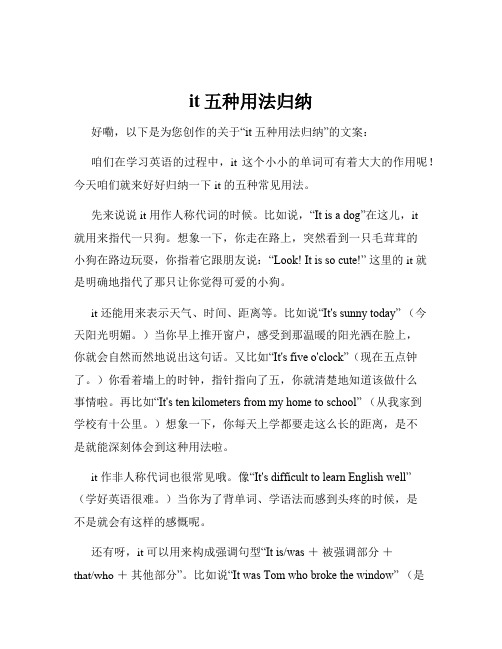
it五种用法归纳好嘞,以下是为您创作的关于“it 五种用法归纳”的文案:咱们在学习英语的过程中,it 这个小小的单词可有着大大的作用呢!今天咱们就来好好归纳一下 it 的五种常见用法。
先来说说 it 用作人称代词的时候。
比如说,“It is a dog”在这儿,it就用来指代一只狗。
想象一下,你走在路上,突然看到一只毛茸茸的小狗在路边玩耍,你指着它跟朋友说:“Look! It is so cute!” 这里的 it 就是明确地指代了那只让你觉得可爱的小狗。
it 还能用来表示天气、时间、距离等。
比如说“It's sunny today” (今天阳光明媚。
)当你早上推开窗户,感受到那温暖的阳光洒在脸上,你就会自然而然地说出这句话。
又比如“It's five o'clock”(现在五点钟了。
)你看着墙上的时钟,指针指向了五,你就清楚地知道该做什么事情啦。
再比如“It's ten kilometers from my home to school” (从我家到学校有十公里。
)想象一下,你每天上学都要走这么长的距离,是不是就能深刻体会到这种用法啦。
it 作非人称代词也很常见哦。
像“It's difficult to learn English well”(学好英语很难。
)当你为了背单词、学语法而感到头疼的时候,是不是就会有这样的感慨呢。
还有呀,it 可以用来构成强调句型“It is/was +被强调部分+that/who +其他部分”。
比如说“It was Tom who broke the window” (是汤姆打破了窗户。
)就好像你在教室里,突然听到玻璃破碎的声音,大家都在猜测是谁干的,最后发现是汤姆,这时候强调句型就能很好地表达出来啦。
最后,it 还能用于某些固定句型中,比如“make it”(成功;做到)。
当你一直努力准备考试,最后终于取得了好成绩,你就可以骄傲地说:“I made it!” (我做到了!)总之,it 的用法多种多样,咱们在学习的过程中要多留意、多练习,这样才能熟练掌握。
英语it用作人称代词的用法

英语it用作人称代词的用法大多数代词具有名词和形容词的功能。
英语中的代词,按其意义、特征及在句中的作用分为:人称代词、物主代词、指示代词、反身代词、相互代词、疑问代词、关系代词、连接代词和不定代词九种。
那么,it 用作人称代词,又有哪些需要关注的点呢?下面请跟随小编的脚步,一起来探讨吧。
it用作人称代词的用法1. 用于指事物it用作人称代词最基本的用法就是代替前面已提到过的事物,以避免重复:This is my watch, it’s a Swiss one. 这是我的手表,它是瑞士制的。
I cannot find my watch; I must have lost it. 我找不到手表,我一定把它给丢了。
2. 用于指动物或婴儿除用于指代事物外,还可指动物或性别不详的婴儿:“Where is the cat?” “It’s under the bed.” “ 猫在哪儿?”“在床下。
”They got a baby and it was very lovely. 他们生了个孩子,很可爱。
3. 用于上文提到的情况He smokes in bed and I don’t like it. 他在床上抽烟,我不喜欢他这样。
Her mother kept telling her not to go out at night, but it didn’t help. 她母亲老叫她晚上不要出去,但是没用。
4. 用于指人it用于指人主要用确定未知人的身份:“Who is it?” “It’s me.” “是谁啊?”“是我。
”“Listen. Someone is crying.” “Oh, it must be Mary.” “听,有人在哭。
”“噢,一定是玛丽。
”Someone must have been here. But we have no idea who it was. 一定有人来过,但我们不知道是谁。
高考英语:it的用法
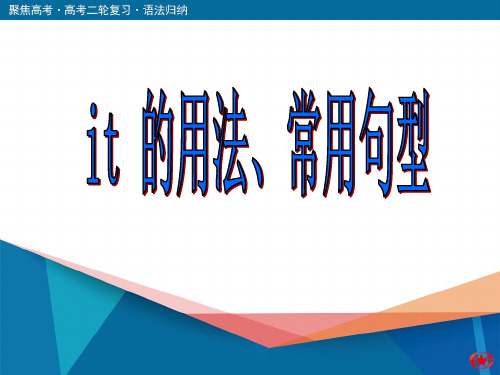
2)真实主语是主语从句。常见句型如下: a. It + be +名词+主语从句。如:
It is a great pity (that) he can't swim. It was no accident (that) such a book (should) appear in the 18th century. It was a puzzle whether he should get married. It was a mystery how the thieves got in.
from a store kman that Alice bought from a store last week. (强调宾语a walkman)
③It was from a store that Alice bought a Walkman last week. (强调地点状语from a store)
4. 强调句型用于特殊疑问句,被强调的通常 是疑问词。
注意:此强调句型不能强调谓语动词。若需 强调谓语动词,常用“助动词do / does / did + 动词原形”。
四、一些含it的固定句型 As someone puts it, ... 像某人所说的那样,…… Please see to it that ... 请务必…… When it comes to ... 当提到……时 It looks / seems as if ... 看起来好像…… It's time for sth. 该做某事了
it用法大全(形式宾语形式主语)
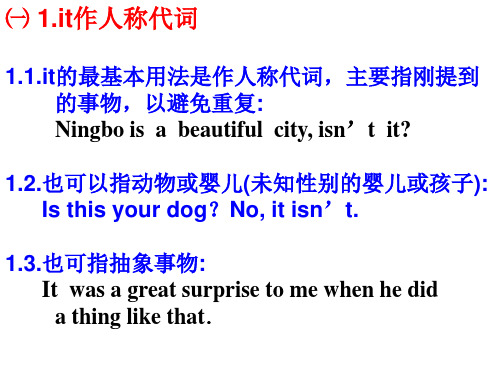
3).It +n+that ... 1. It is a pity ( a shame ... ) that ...
that后的从句一般用虚拟语气(should + 动词原形), should可省去.表示出乎意料,常译为“竟然”。没有 这种意义时,则不用虚拟语气。
It doesn’t matter if they are old.
.2.作形式主语替代不定式
1). It takes sb. ... to do sth. "做...要花费某人.." It took thousands of people many years to build the Great Wall.
2.非人称代词it
it有时并不指具体的东西,而泛指天气、时间、环境等, 称为非人称的it: 2.1.指天气: It is a lovely day, isn’t it? It is a bit windy.
2.2.指时间: It was nearly midnight when she came back.
2).It is +v-ed +that 从句 ① It is said (reported, learned....) that ...
据说(据报道,据悉...)“。 It is said that he has come to Beijing.
= He is said to have come to Beijing.
难怪他不愿去。 在该句型中如果用肯定形式,表示“真奇怪, 真是令人惊讶”;
It is a wonder that he reused such a good offer.
高中英语it的用法的归纳总结

高中英语it的用法的归纳总结1. it 作为人称代词在句子中代替一个名词或代词,作为主语、宾语、表语或形式宾语等。
例句:It is raining heavily.The book is interesting. I love it.I find it difficult to understand.2. it 作为代词形式的宾语用在像 think, believe, find, consider, call 等动词后面,作为宾语,这些动词有时常被称为“感觉类动词”。
例句:I find it hard to believe that he would do such a thing.They called it a day and went back home.I consider it a waste of time to keep trying.3. it 作为形式宾语用在像 make, find, see, hear, feel 等动词后面,表示动作的对象。
例句:They made it clear that they would not accept the offer.I find it interesting to learn new things.I saw it with my own eyes.4. it 作为虚拟主语或虚拟宾语用在像 suggest, insist, demand, prefer 等动词后面,表示虚拟语气。
例句:The boss suggested that it would be better to start the project next month.She insisted that it was her right to make the decision.I demand that it be done as soon as possible.5. it 作为强调的主语或宾语用在像 be, have 等动词后面,表示强调。
it的用法、常用句型

I’d prefer it if I didn’t have to do so much
work.
I would appreciate it very much if you would
help me with it.
b. 动词+介词+ it + that从句 能用于此句型的主要有:depend on, answer for, see to。如: You may depend on it that he will turn up in time.
reputation of an honest man.
It was no accident that such a book should
appear in the 18th century. 2) “It + be +形容词+主语从句”中从句谓语常用 “(should +)动词原形(或完成时)”。常用 于本句型的形容词主要有impossible, strange,
2. —Steven’s parents have bought him a computer.
—__I_t _ __is__ __n_o_ _w__o_n_d_e_r_ (难怪) that he looks so happy.
3. Susana’s aim is to tell all citizens they have a duty to protect the environment, _is_n_’_t_ __it_ (对吗)?
2. Raise your leg and let 65 stay in the air for seconds. (辽宁2014第三部分)
It的各种用法
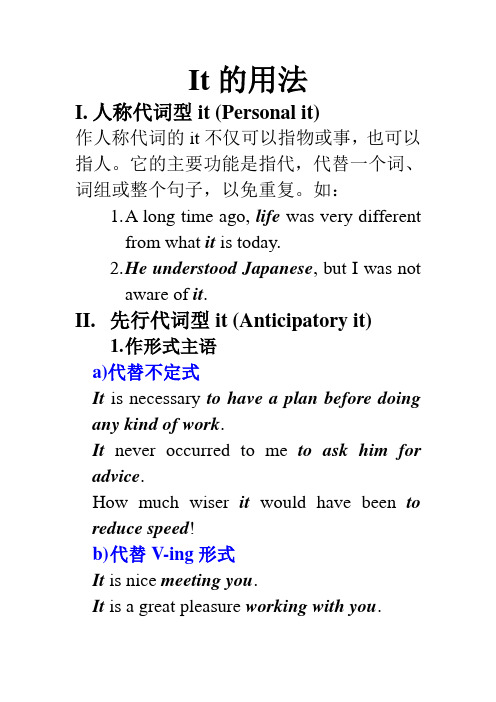
It的用法I.人称代词型it (Personal it)作人称代词的it不仅可以指物或事,也可以指人。
它的主要功能是指代,代替一个词、词组或整个句子,以免重复。
如:1.A long time ago, life was very differentfrom what it is today.2.H e understood Japanese, but I was notaware of it.II.先行代词型it (Anticipatory it)1.作形式主语a)代替不定式It is necessary to have a plan before doing any kind of work.It never occurred to me to ask him for advice.How much wiser it would have been to reduce speed!b)代替V-ing形式It is nice meeting you.It is a great pleasure working with you.It wouldn’t be any good (my) talking to him.=It wouldn’t be any good for me to talk to him.c)代替主语从句It was the rule of the school that the pupils should wear their school uniforms.It seems that you know a lot about your new teacher.It is likely that he will retire next year.It is said that most people in the village live to over one hundred.2.作形式宾语a)代替不定式He found it interesting to be a touristguide.These young people made it theirbusiness to take care of the old peoplein the neighborhood.b)代替V-ing形式I don’t think it worthwhile taking toomuch trouble.c)代替宾语从句Mr. White made it clear that thestudents should prepare every lesson.I owe it to you that I passed theEnglish test.We find it a mystery that Alex hasnever mentioned his parents.III.非人称代词型it (Impersonal it)1.指时间It’s nine o’clock now.It will be Sunday tomorrow.It was nearly Christmas when I heardmother got a job at a railway station.It is ten years since we got to know eachother.2.指天气、季节It is getting hotter and hotter here.It will be summer in two weeks’ time.3.指距离It is ten miles from here.It’s only a short distance to the shoppingcenter.4.指环境或情况It’s too noisy for me to study here.Whose turn is it next?It was exciting when we watched theastronauts taking spacewalks.IV.强调型it (Emphatic it)强调句型:It + be + 被强调部分+that (指人时可用who) + 其他成分1.强调主语It was clearly the headmaster himselfwho/that opened the door.It was his working during the weekendthat exhausted him.2.强调宾语It was me whom/that he sent a New Yearcard to. (Oi)It was a New Year card that he sent me.(Od)3.强调状语It was not until he got a map that he started on his way.It might have been in the store that I lostmy purse.4.强调宾语补足语It was light blue that Ted painted hisbedroom.5.强调主语补足语It is Little Tiger that he is called.V.it的习惯用法(Idiomatic it)it的习惯用法较多出现在口语或非正式文体中,这种it已失去了它的原意。
- 1、下载文档前请自行甄别文档内容的完整性,平台不提供额外的编辑、内容补充、找答案等附加服务。
- 2、"仅部分预览"的文档,不可在线预览部分如存在完整性等问题,可反馈申请退款(可完整预览的文档不适用该条件!)。
- 3、如文档侵犯您的权益,请联系客服反馈,我们会尽快为您处理(人工客服工作时间:9:00-18:30)。
关于it作人称代词的用法:1. 用于指事物it用作人称代词最基本的用法就是代替前面已提到过的事物,以避免重复:This is my watch, it’s a Swiss one. 这是我的手表,它是瑞士制的。
I cannot find my watch; I must have lost it. 我找不到手表,我一定把它给丢了。
2. 用于指动物或婴儿除用于指代事物外,还可指动物或性别不详的婴儿:“Where is the cat?” “It’s under the bed.” “猫在哪儿?”“在床下。
”They got a baby and it was very lovely. 他们生了个孩子,很可爱。
3. 用于上文提到的情况He smokes in bed and I don’t like it. 他在床上抽烟,我不喜欢他这样。
Her mother kept telling her not to go out at night, but it didn’t help. 她母亲老叫她晚上不要出去,但是没用。
4. 用于指人it用于指人主要用确定未知人的身份:“Who is it?” “It’s me.” “是谁啊?”“是我。
”“Listen. Someone is crying.” “Oh, it must be Mary.” “听,有人在哭。
”“噢,一定是玛丽。
”Someone must have been here. But we have no idea who it was. 一定有人来过,但我们不知道是谁。
5. 指人时与he和she的区别当it用于指人时,主要用于确定未知的或者是身份不明的人,若是指已知的或身份明确的人,则应根据情况使用he或she。
比较:I hear a knock at the door. It must be the postman. 我听见有人在敲门,一定是邮递员来了。
Jim is at the door. He wants to see you. 吉姆在门口,他想见你。
A tall man stood up and shook hands with her. It was the general manager. 一个高个子站起来同她握了手,他是总经理。
The general manager just called. He told us to wait for him at the gate. 总经理刚来过电话,他叫我们在门口等他。
6. 指物时与one的区别两者均可代替前面提到的事物,区别是:it指的是与前面已提到的事物为同一物,此时的it等于“the (this, that, my...)+名词”;而one 指的是与前面已提到的事物为同一类物,此时的one等于“a+名词”。
比较:I have a dictionary but I’ve lent it to Mary. 我有一本词典,但把它借给玛丽了。
I haven’t a dictionary; can you lend me one? 我没有词典,你能借我一本吗?it用作形式宾语的四个特殊句式:当不定式、动名词、从句等复杂成分用作宾语且其后跟有宾语补足语时,通常会在宾语补足语前使用形式宾语it,而将真正的宾语移至句末,其基本结构为“动词+it+宾语补足语+不定式(动名词或从句)”。
如:I find it difficult to do the job well. 我发现做好这件事不容易。
I think it best that you should stay here. 我认为你最好住这儿。
We think it no use complaining. 我们认为抱怨是没有用的。
但是,以下几种形式宾语比较特殊,同学们需引起注意(同时它们也是高考的常考考点):1. 动词+ it + that-从句。
如:I like it that you came. 你来了,我很高兴。
I take it (that) he will come on time. 我认为他会准时来的。
You can put it that it was arranged before. 你可以说这是以前安排的。
Rumor has it that the defence minister will soon resign. 据传闻,国防部长不久就要辞职。
说明:能用于此结构的动词不多,常见的有have, take, put, like 等。
2. 动词+ it + when (if)-从句。
如:I dislike it when you whistle. 我不爱听你吹口哨。
We really appreciate it when she offered to help. 她来帮忙了,我们十分感激。
I’d prefer it if I didn’t have to do so much work. 要是我不必做那么多工作,好就太好了。
说明:能用于此结构的动词不多,常见的有enjoy, hate, love, like, dislike, appreciate, prefer 等。
3. 动词+ prep+ it + that-从句。
如:See to it that you’re not late again. 注意千万不要再迟到。
Look to it that this doesn’t happen again. 注意不要再发生这种事。
I can’t answer for it that he will come. 我不能保证他会来。
You may rely on it that he’ll come to meet you. 你放心,他会来接你的。
说明:能用于此结构的动词不多,常见的有see to, look to, insist on, stick to, depend on, answer for 等。
4. 动词+ it + 介词短语+ that-从句。
如:I owe it to you that I am still alive. 多亏有你我才仍然活着。
I took it for granted that he would help us. 我认为他会帮助我们的。
说明:能用于此结构的动词不多,常见的有take it for granted, bring it to sb’s attenti on, owe it to sb 等。
it用法完全归纳一、it 作人称代词的用法1.指事物作为人称代词,it 可以除人以外的一切事物或动物。
如:I dropped my watch and it broke. 我把手表掉在地上摔坏了。
It’s hard work, but I enjoy it. 工作很辛苦,可是我乐意干。
“Where is the dog?”“It’s in the bedroom. ”“狗在哪?”“在卧室里”。
2.指人it 指人主要用于指不性别不明的婴儿或用于确认某人的身份。
如:Is it a boy or a girl? 是男孩还是女孩?There is a knock on the door. It must be the postman. 有人在敲门,一定是邮递员。
【说明】在答语中,常用来指本人,如说It’s me。
3.代替某些代词代词it 还可用于代替指示代词this, that 以及复合不定代词something, anything, noth ing等。
如:“What’s this?”“It’s a new machine. ”“这是什么?”“是一种新机器”。
Nothing is wrong, is it? 没出什么问题,是吗?二、it 作非人称代词的用法1.基本用法it 作非人称代词的用法,主要用于指时间、距离、价值、天气、气候及温度等自然现象。
如:It’s too late to go there now. 现在去那儿已经太迟了。
It rained all day yesterday. 昨天下了一天的雨。
It can get very hot here. 这里有时会很热。
2.用于某些句型It’s time for sth. 该做某事了。
It’s time to do sth. 该做某事的时候了。
It’s time for sb to do sth. 某人该干某事了。
It’s (about / high) time + that-从句. 某人该做某事了。
(从句谓语用过去式,有时也用“s hould+动词原形”)It’s first (second) time + that-从句. 某人第几次干某事。
(从句谓语用现在完成时) It’s + 时间段+ since-从句. 自从……有一段时间了。
It’s + 时间段+ before-从句. 过多长的时间才……三、it用作形式主语1.基本用法当不定式、动名词、从句等复杂成分用作句子主语时,为保持句子平衡,通常把真正的主语放在句末,而在句首使用形式主语it。
如:It’s very important to remember this. 记住这一点很重要。
It’s hard work climbing mountains. 爬山是费劲的事。
It’s unknown when he will come. 他什么时候来还不知道。
2.用作形式主语的的重要句型(1)It + be + adj. for (of) sb to do sth 某人做某事……It is hard for him to make up his mind. 他很难下定决心。
It was foolish of her to say such a thing. 她说那样的话,真是太蠢了。
【说明】介词of 与for 的区别是:of 用于指某人的性格、属性、特征等,介词for 表示对象,意为“对……来说”(from )。
(2)It takes sb + 时间段+ to do sth. 某人做某事花了……时间It takes years to master a new language. 要花多年的时间才能掌握一门新的语言。
【说明】此句型可以有以下多变种变体:It took me an hour to write the letter. =The letter took me an hour (to write). =I took an hour to write the letter. 我写这封信花了一个小时。
(3)It is up to sb to do sth. 该由某人做某事It’s up to you to to make the choice. 得由你来作选择。
